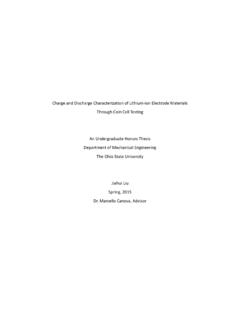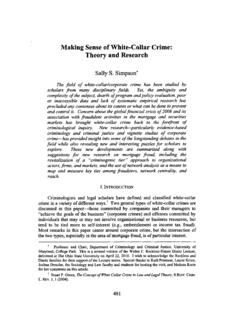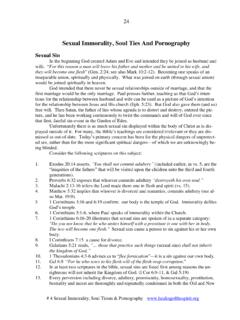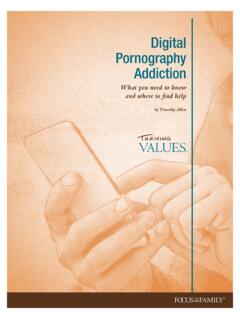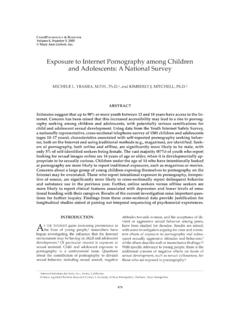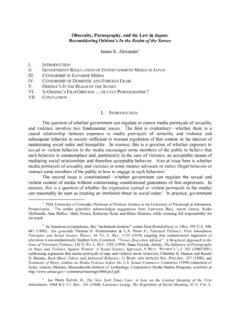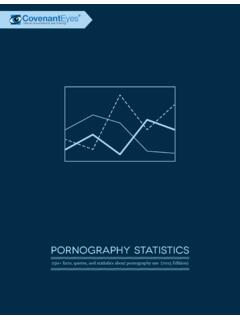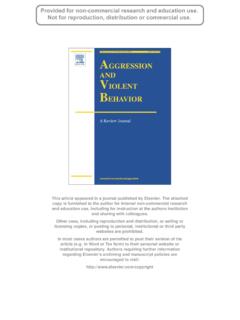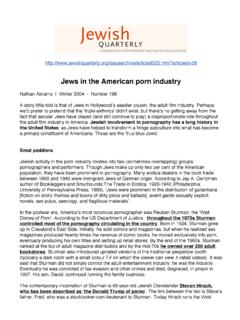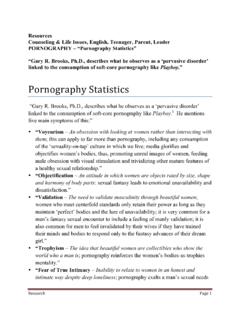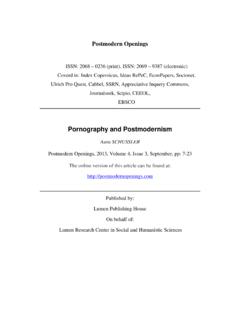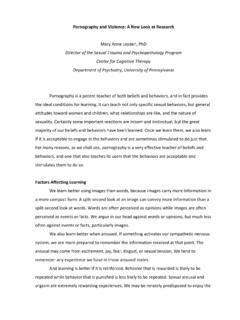Transcription of Greenberg, Dan; Tobiason, Thomas H. - Ohio State University
1 The New Legal Puritanismof Catharine MacKinnonDAN greenberg * Thomas H. tobiason **By rejecting traditional legal definitions of "obscenity," ProfessorCatharine A. MacKinnon has successfully revived debate on questions Her work has called into question the consensus view thatpornography regulation has dire implications for constitutionally guaranteedfreedoms of speech and of the Although others have made argumentsfor prohibiting pornography ,3 this Article focuses primarily on the powerfullyoriginal work of Professor Article does not concentrate on the legislation that MacKinnon wasinstrumental in drafting,4 but rather on the ideas that animated it. We arguehere that while her critique of pornography has had the salutary effect ofshifting the inquiry from aesthetic or "moral" considerations to the specificharms that pornography allegedly creates, her approach is fatally defective bothin theory and in practice. Part I of this Article gives an account of the relevantlegal background (the law of obscenity) and the traditional ways that scholarshave thought about the problems pornography poses.
2 Part II sets forthMacKinnon's rejection of obscenity doctrine, her redefinition of pornography ,and her proffered reasons for prohibition. Finally, Part M consists of a critiqueof MacKinnon's approach. In it, we analyze her conceptions of both causationand consent; we describe broad sectors of art and literature that are at risk if a* Dan greenberg , , Brown Umversity, 1988; , Bowling Green StateUniversity, 1990; currently Congressional Analyst, United States Congress AssessmentProject, Heritage Foundation.** Thomas H. tobiason , , Brown University , 1988; , University ofMichigan, 1992; currently associate, Latham & Watkins, Costa Mesa, California. Theauthors wish to thank Paul greenberg , Todd Seavey, Eddie Yegluayan, and the editors ofthis Journal for their helpful See Catharne A. MacKinnon, Not a Moral Issue, 2 YALE L. & PoL'Y REv. 321,322-24 (1984) (distinguishing "the male morality of liberalism and obscemty law from afeminist political critique of pornography ").
3 2 See I at 322, See, , ANDREA DWORKN, pornography : MEN POSSEssiNG WomEN 9 (1981)(defining pornography as "the graphic depiction of women as vile whores" and arguing thatwomen will never be free as long as pornography exists); Cass R. Sunstem, Pornographyand the First Amendment, 1986 DUKE 589 (1986) (arguing that " pornography is low-value speech entitled to less protection ..than most forms of speech").4 See INDIANAPOLIS, IND., CODE 16-3(q) (1984). This legislation, drafted byProfessors MacKinnon and Dworkin, was declared unconstitutional. American BooksellersAss'n v. Hudnut, 771 323 (7th Cir. 1985), aft'd, 475 1001 (1986).OHIO State LAW JOURNALMacKinnonite approach is followed; we analyze her rhetorical and theoreticalorientation; and we conclude that the radical nature of her argument renders herproposals deeply LEGAL BACKGROUND: OBSCENITY AND MORALITY"I know it when I see it."-Justice Potter Stewart5A. Historical Development of Obscenity LawThe proscription of sexually explicit material has deep historical roots.
4 Inphilosophy, its genesis can be traced to Plato, who banished the artist from hisideal At root, the reasons for Plato's proscription were moral: Plato wasgreatly offended by depiction of Olympian (Aristotle, incontradistinction, extolled the cathartic effects of art, especially tragedy.)8 Modem Anglo-American law still bears traces of the fears expressed in theRepublic that immoral art could corrupt the citizenry. English censorship ofexpression initially appeared to be more concerned with religious and politicalthemes than with sexual The first reported obscenity cases in the5 lacobellis v. Ohio, 378 184, 197 (1964) (Stewart, J., concurring).6 PLATO, The Republic, in PLATO: COLLECrED DIALO outs passim (Edith Hamilton &Huntington Cairns eds. & Paul Shorey trans., 2d prtg. 1963).7 Id. at 630-44, verses 386-99 (denouncing, inter alia, Homer's depictions of fear,Priam "rolling m the dung," violent laughter, and Zeus' being "so overcome by the sight ofHera that he is not even willing to go to their chamber, but wants to lie with her there onthe ground"); cf.
5 OviD, THE ART OF LovE 105, bk. II, verses 579-86 ( Goold ed. & Mozely trans., 2d ed. 1979) (recounting the amatory episode of Mars and Venus).8 ARISTOTLE, Poetics, in BASIC WORKS OF ARISTOTLE 1455, 1457-58, 1460, 1487(Richard McKeon ed., 1941).9 LAURENCE H. TRIBE, AMERICAN CONsTrrurroNAL LAW 12-16, at 905 (2d ). The classic argument against an unfree (m this case, licensed) press is in JohnMilton's Areopagitica. His arguments can be categorized as (1) the historical failure ofcensorship and (2) the denigrating (and to that extent un-Chnstian) nature of censorship: weshould 'have confidence m truth's ability to prevail. JOHN MILTON, Areopagitica, inCOMPLETE POEMS AND MAJOR PROSE 717 (Merrit Y. Hughes ed., 1957). This idea,presaged by Esdras, is closely related to the Holmesian notion of a marketplace of BENN=T, ANTHONY COMSTOCK 1119 (Leonard W Levy ed., 1971) (1878)(quoting Esdras: "As for truth, it endureth and is always strong: it liveth and conquereth forevermore.)
6 "). Milton seemed to see virtue m a Millian clash with falsehood:I cannot praise a fugitive and cloistered virtue, unexercised and unbreathed, that neversallies out and sees her adversary, but slinks out of the race where that immortal1376[Vol. 54:1375 NEWLEGAL PURITANISMU nited States occurred in the early part of the nineteenth century 10 States soonpassed obscenity statutes; in 1842, the federal government enacted a statuteattempting to eliminate commerce m French postcards and obscene pictorialmatter. "1 Shortly after the Civil War, Congress, urged by Protestant leaders and aNew York City dry goods clerk named Anthony Comstock, enacted legislationprohibiting Comstock, an amalgam of the worst qualities of JosephMcCarthy and Barnum, had little doubt about or patience for the works hefound obscene (they included Boccaccio's Decameron and the works of Zola,Daudet, and Bazac): "The effect of this cursed business on our youth andsociety, no pen can describe. It breeds lust.]
7 Lust defiles the body, debauchesthe imagination, corrupts the mind, deadens the will, destroys the memory,sears the conscience, hardens the heart, and damns the soul."13 Comstockreceived financial support from Morris K. Jesup, who, in the words of , was "very rich, and very eager to bring the whole nation up to graceby force majeure."14 Together, the two founded the YMCA Committee for theSuppression of Vice, whose formidable outgrowth was the New York Societyfor the Suppression of As secretary of the New York Society,Comstock was authorized to make arrests; he is said to have acted as an agentprovocateur to sniff out peccant Soon Comstock's crusadebecame national. As a post office agent, he launched spectacular raids andproceeded to organize antivice societies throughout the In 1873,amid intense lobbying by Comstock and his backers, President Grant signedvaguely worded legislation authorizing criminal penalties against sendinggarland is to be run for, not without dust and heat that which purifies us is trial andtrial is by what is , supra William B.
8 Lockhart & Robert C. McClure, Literature, the Law of Obscenity, andthe Constitution, 38 MINN. L. REv. 295,324 & (1954).11 TRIBE, supra note 9, 12-16, at 906 (citing 5 Stat. 566 (1842)).12 COMMIION ON pornography , ATT'Y GEN., FINAL REPORT OF THE ATTORNEYGENERAL'S COMMISSION ON pornography 12 (1986) [hereinafter FiNAL REPORT]; FELICEF. LEwis, LiTERATURE, OBscENry, & LAw 10-11 (1976); MENCKEN, A BOOK OFPREFACES 255-60 (5th ed. 1924). See generally HEYWOOD BROUN & MARGARET LEACH,ANrHONY COMsTocK 158-59 (1927).13 LEWis, supra note 12, at 12; cf. In re Worthington Co., 30 361 (1894)(holding rare and costly editions of Arabnan Niglh, Ovid's Art of Love, Fielding's TomJones, and other works not obscene).14 MENCKEN, supra note 12, at 25715 LEWIS, supra note 12, at BROUN& LEACH, supra note 12, at 158-59; BENNETT, supra note 9, at LEWIS, supra note 12, at ]1377 OHIO State LAW JOURNAL obscene material through the As early as 1878, Comstock's mercilessprosecution and gleeful indifference to those whose lives he ruined earned himthe title of "first-class Torquemada.
9 "19 Toward the end of his life, Comstockboasted that he had "convicted persons enough to fill a passenger train of sixty-one coaches, sixty coaches containing sixty passengers each and the sixty-firstalmost full. I have destroyed 160 tons of obscene literature."20 Prior to the latter part of the nineteenth century, when the efforts ofComstock and his adherents prevailed on courts and legislatures alike,American courts had not attempted to define But across theAtlantic,; Lord Chief Justice Cockburn, m The Queen v. Hicklin,22 haddeveloped a "sensitive-person" test of obscenity- "whether the tendency of thematter , is to deprave and corrupt those whose minds are open tosuch immoral influences, and into whose hands a publication of this sort mayfall."23 American courts soon adopted the Hicklin test,24 by which TheodoreDreiser's An American Tragedy and Lawrence's Lady Catterley's Loverwere declared obscene in Three years later, however, the Hicklin testreceived a devastating blow.
10 A New York federal district court refused to applyit, stating: "It is only with the normal person that the law is concerned."26 Applying this standard, Judge Woolsey found that James Joyce's Ulysses was18 Id.; see An Act for the Suppression of Trade in, and Circulation of, obsceneLiterature and Articles of immoral Use, ch. 258, see. 2, 148, 17 Stat. 598, 599 (1873).19 BENNEIT, supra note 9, at 0 NALRJEpORT, supra note 12, at See id. at 12-13; Lockhart & McClure, supra note 10, at [1867-68] 3 Id. at See, , Rosen v. United States, 161 29, 43 (1896); United States , 209 F. 119, 120 ( 1913) (Hand, J.) (applying and criticizing the test);United States v. Clarke, 38 F. 732, 733 ( Mo. 1889); United States v. Bebout, 28 , 524 ( Ohio 1886); People v. Muller, 96 408, 411 (1884).25 Commonwealth v. Fnede, 171 472 (Mass. 1930); Commonwealth v. Delacey,171 455 (Mass. 1930). See generally LEwis, supra note 12, at 92-93, United States v. One Book Called "Ulysses," 5 F Supp.






